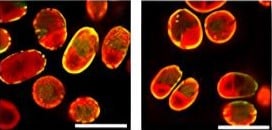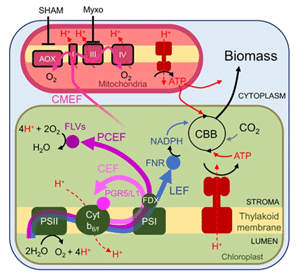An international collaboration between BIAM researchers and the Carnegie Institution for Science in Stanford (USA) has revealed how solar energy is supplied to metabolic reactions of algal cells to fuel atmospheric CO2 fixation. This discovery provides an understanding of the fundamental basis for efficient CO2 sequestration by microalgae.

This discovery offers an in-depth understanding of the fundamental mechanisms underlying efficient CO₂ sequestration by microalgae. During conversion of solar energy by photosynthesis different electron pathways are generated, thus creating a proton motive force (pmf) across biological membranes. The pmf is then utilized to generate ATP an important cellular energy currency. Until now, the main electron pathway (known as the Z scheme) has been considered the major driver, and the contribution of the other pathways (known as alternative pathways) has been largely underestimated.
Using the green alga Chlamydomonas as a model organism, BIAM researchers (CEA, CNRS, AMU) have shown that alternative pathways are essential for CO2 fixation, can widely replace each other in supplying extra energy for photosynthesis, and that the alternative pathway resulting from cooperation between chloroplasts and mitochondria is the most efficient for carbon sequestration.
By showing the redundancy between the different pathways, this work illustrates the flexibility of photosynthesis and further provides a basis for planning strategies to enhance carbon fixation in photosynthetic organisms.
The ‘Z’ scheme of photosynthesis and alternative electron transfer pathways
The ‘Z’ scheme is the main pathway for electron transfer during photosynthesis. The electrons produced during the photolysis of water in photosystem II are transferred to photosystem I, enabling the production of NADPH (reducing power). During the ‘Z’ scheme, a proton motive force is produced, enabling the synthesis of ATP (phosphorylating power). NADPH and ATP are used to provide energy to the cell for the metabolic reactions that fix CO2.
Alternative electron transfer pathways are additional pathways that allow cells to produce the extra phosphorylating capacity required for efficient CO2 fixation. Various alternative pathways have been described, such as the cyclic transfer of electrons around photosystem I or the transfer, followed by conversion to ATP, of the reducing power produced in the chloroplast to the mitochondria.
DOI: https://doi.org/10.1093/plcell/koae143
*Collaboration:
1 Aix Marseille Univ, CEA, CNRS, Institut de Biosciences et Biotechnologies Aix-Marseille, CEA Cadarache, 13108 Saint Paul-lez-Durance, France
2 Department of Plant Biology, The Carnegie Institution for Science, Stanford, CA, 94305 USA
3 Department of Biology, Stanford University, Stanford, CA, 94305, USA
Authors:
Gilles Peltier1, Carolyne Stoffel2, Justin Findinier2, Sai Kiran Madireddi2, Ousmane Dao1, Virginie Epting1, Arthur Grossman2,3, Yonghua Li-Beisson1, Adrien Burlacot2,3*
